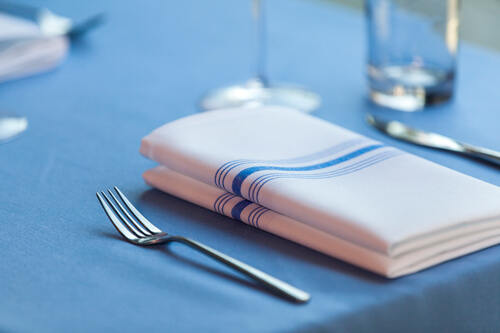BASIC REQUIREMENTS:
1. Equipment must be free of burrs and sharp edges.
2. Washing equipment should have properly functioning water level and temperature controls.
3. Follow normal extraction procedures on cool (90˚-100˚ F) linens.
4. Cleaning and waxing of ironer chest, and maintenance of roll pads and covers should comply with ironer manufacturer’s
recomendations. Maintain chest temperature between 310˚ F and 325˚ F on gas, steam, electric, and thermal fluid ironers.
5. Chemical feed systems must be functioning properly.
PROCESSING REQUIREMENTS:
1. Before placing new linen into service, it should be washed separately to remove manufacturing residual dyes. Darker
shades should always be washed separately for five (5) washes.
2. Shade groups such as whites, darks, mediums, lights and reds should always be washed separately.
Contact your Milliken representative for further information on shade groupings.
3. Milliken napery fabrics should be washed separately from 100% Cotton and Poly/Cotton blends to avoid contamination
from lint and insure proper cleaning.
4. All linen must be shaken out so debris (paper, trash, food, sharp objects and any other foreign matter) will not be loaded
into the washer with the table linen.
5. Wash formula and wash chemicals should be appropriate for type and amount of soil to be removed.
6. Surfactants are recommended in the break cycle.
7. Soaps of animal or vegetable fats should be avoided.
8. Bleaches should not be used on colored Milliken napery.
9. White Milliken napery should receive antichlor treatment after hypochlorite or other chlorine bleaching.
10. For good mechanical action, load washwheel: Full Drop - 90% Split Poocket -75% Y-Pocket - 65%
11. Softeners and waxes must not be used with Milliken napery, as these will mask the absorbency of the fabric.
12. Adequate rinsing to remove residual chemical is necessary to ensure maximum fabric life and color retention.
PROCESSING REQUIREMENTS FOR ALL SIGNATURE STRIPE,
INCLUDING CHAMBRAY AND CHECKPOINT:
1. All requirements as stated above.
2. All Signature Stripe and CheckPoint fabrics should be washed in White loads to not have dye transfer on to white areas.
For Laundries With Finishing Equipment
SUGGESTED WASH FORMULAS & CHEMICAL SUPPLIES FOR MILLIKEN NAPERY:
Remember, this formula is a recommended starting point. Depending on your current situation, you may need to make changes.
*The true measure of alkalinity is PPM.
**Do NOT lower the temperature by more than 15 degrees per step. Set rinse temperatures based upon wash temperatures.
STARCHING AND/OR SIZING OF MILLIKEN NAPERY:
A clean fiber surface with good water absorbency is essential for proper starching or sizing of Milliken napery. To test quickly, place a
few drops of water on a clean, ironed, cool, dry napkin. If water is completely absorbed into fabric within three (3) seconds, proper
adhesion and film formation of starch or size should occur. Absorbency time in excess of three (3) seconds will require adequate clean
up prior to starching or sizing.
- Sour should be added to the wheel and allowed to dispense prior to adding starch or size. We suggest addition of sour two
(2) minutes prior to addition of starch or size. This will help avoid differential absorption resulting in hard and soft spots in the
napery. Sour should be added to achieve a ph of 5.5 to 6.5.
2. Starch or size should be applied during the sour step of the formula. Water level should be as low as practical (3” to 6” above
basket). Water temperature should be maintained in the 90˚ F to 100˚ F range to facilitate dispersion and avoid highlighting.
3. Wheel should be allowed to run eight (8) to ten (10) minutes after addition of starch or size to allow even penetration of the
dispersion throughout the load.
4. Twelve (12) to twenty-four (24) ounces per hundred weight of starch or combined starch and size is generally adequate to cover
the range of aesthetics desired by restaurant customers. Corn, wheat and rice pregelantinized (dry to the wheel) starches as well
as most cooked starches have all been found to work well on Milliken napery. Synthetic size in conjunction with starch also
works well for those accounts who desire extra firmness. We suggest you contact your Milliken Technical Representative for
assistance in selection and use of these products. Synthetic size must be removed with each wash.
5. If possible, use sufficient extraction to permit napery to be ironed without tumbling. Excessive tumbling will reduce the
effectiveness of the starch or size significantly.
There you have it, some recommendations for handling Milliken napery fabrics.
Shop for Milliken Napery Now!

Direct Textile Store ships to all US states, including Alaska and Hawaii, US Territories, Canada, Puerto Rico, St. Thomas, and St. Croix.






